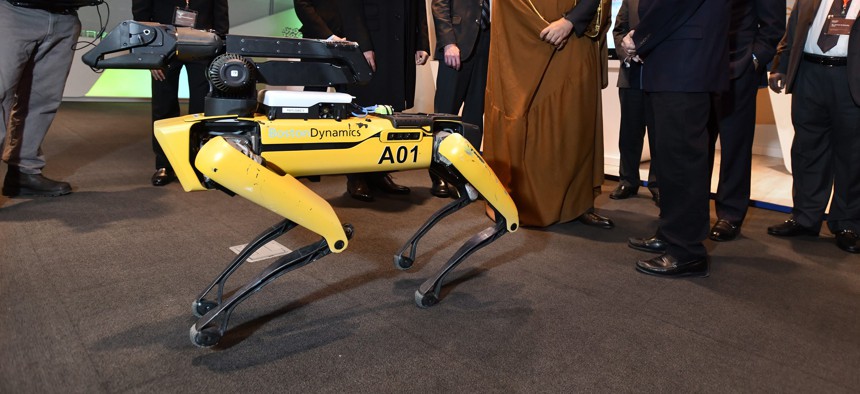Police Departments Experiment With 70-Pound Robot Dog

A model of the "SpotMini" robot dog by Boston Dynamics seen at an event in 2018. Josh Reynolds/AP Images for KAUST
Departments have deployed the cyber K-9s in hostage situations and as part of the covid response. Proponents say the robots can help keep officers out of harm's way, while critics worry how they could be used without clear policy guidelines in place.
The video clip shows a robotic dog—blue, with a square-ish body, backward-bending legs and no head to speak of—trotting down a street in the Bronx. As it marches nimbly by parked cars, flanked by members of the New York City Police Department, an unidentified onlooker states, flatly, “That thing is creepy.”
Meet Digidog, a 70-pound robot equipped with cameras, lights and a two-way communication system that allows the officer controlling it to see and hear its environment in real time. The NYPD acquired the robot in December and has so far used it in active duty three times, including last Tuesday, when it climbed the stairs to a Bronx apartment in search of two suspects in an ongoing investigation. (The apartment was empty, police said later.)
The robot, sold as “Spot” by robotics company Boston Dynamics, costs $74,000 in its most bare-bones package. NYPD officials have said it’s a promising new technology that could save lives and reduce risk for police officers by collecting intel in risky places and eliminating the need to send humans into compromising situations. (Last fall, for example, it was used to send food into an active hostage situation in Queens, according to a local ABC affiliate.)
“The N.Y.P.D. has been using robots since the 1970s to save lives in hostage situations & hazmat incidents,” the department said on Twitter. “This model of robot is being tested to evaluate its capabilities against other models in use by our emergency service unit and bomb squad.”
The technology wasn’t designed specifically for policing and is used mostly by corporate and utility customers, including National Grid, a natural gas and electricity company in New England, and Brasfield & Gorrie, a construction firm.
Its use in policing has raised concerns for some, including U.S. Rep. Alexandria Ocasio-Cortez, who represents part of the Bronx. Ocasio-Cortez took to Twitter to criticize last week’s deployment of the robot “for testing on low-income communities of color with under-resourced schools.”
“Please ask yourself: When was the last time you saw next-generation, world-class technology for education, health care, housing, etc. consistently prioritized for underserved communities like this?” she added.
(Above: A February 2021 video from Boston Dynamics demonstrating some of Spot's capabilities.)
Deploying the technology for police surveillance raises a host of other questions as well, said Jay Stanley, a senior policy analyst for the American Civil Liberties Union. Could the robot become autonomous? Is it a good investment at a time when communities are examining the relationship between their police officers and their residents?
“There’s a question of whether police are going to be transparent, have clear policies in place for the use of this technology, and make sure the public is part of the conversation every step of the way,” he said. “New York hasn’t done that.”
The ACLU had similar concerns in Massachusetts, where state police tested Spot for bomb squad usage in 2019. There was no policy in place dictating the robot’s use, which the organization worried could lead to its weaponization.
“We just really don't know enough about how the state police are using this,” Kade Crockford, director of the Technology for Liberty Project at the ACLU of Massachusetts, told WBUR. “And the technology that can be used in concert with a robotic system like this is almost limitless in terms of what kinds of surveillance and potentially even weaponization operations may be allowed.”
Boston Dynamics, the robot’s manufacturer, said later there was a clause in the lease agreement that prevented Spot from being used in any way to “physically harm or intimidate people.”
A third Spot is in use by the Honolulu Police Department, primarily to take temperatures at a tent city for homeless people during the Covid-19 pandemic. That usage has also drawn ire, albeit for different reasons: the dog was purchased using roughly $150,000 of federal coronavirus relief money, Honolulu Civil Beat reported.
John McCarthy, the department’s deputy chief, told the news outlet in a statement that the robot had other pandemic-related uses, including thermal imaging and medicine and food delivery.
“Currently, much of this work is done by officers, some of whom are on overtime pay. In the long run, the Spot robot will save money while keeping officers safe,” he said. “Beyond the pandemic, we plan to use the Spot robot in other HPD operations.”
Kate Elizabeth Queram is a staff correspondent for Route Fifty and is based in Washington, D.C.
NEXT STORY: RPA turns modernization goals into reality





